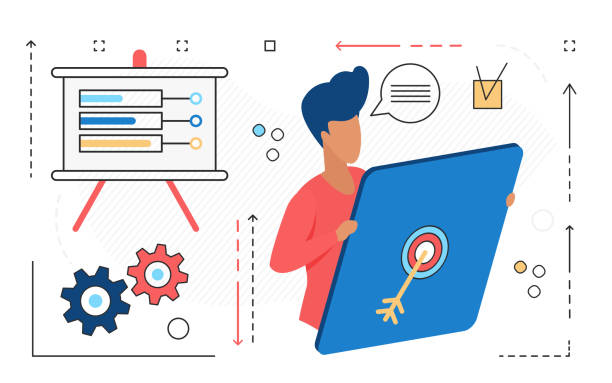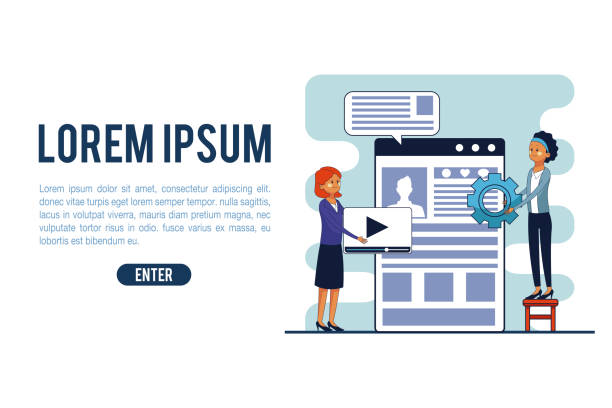The Importance of Entering the Global Market with a Multilingual Website

In today’s world, where geographical boundaries have blurred thanks to the internet, an online presence is vital for any business.
But mere online presence is not enough; to access maximum market potential, we need effective communication with audiences from various cultures and languages.
This is where the importance of multilingual website design becomes more evident than ever.
A multilingual website is a gateway to global markets and endless opportunities.
By providing your content in users’ native languages, you not only demonstrate your credibility and professionalism but also establish a deeper connection with them.
This approach allows you to increase your #global_reach, penetrate new #target_markets, and strengthen your #branding at an international level.
Ignoring this aspect means losing a significant portion of customers and reducing competitiveness.
With business globalization, you can exponentially increase your #business_growth potential.
This is not just an option, but a strategic necessity for survival and prosperity in the digital age.
Therefore, any plan for online business development must include multilingual capabilities and the creation of a comprehensive multilingual platform to meet the diverse needs of global audiences.
Does your current website showcase your brand’s credibility as it should? Or does it drive away potential customers?
Rasawab, with years of experience in professional corporate website design, is your comprehensive solution.
✅ A modern, beautiful website tailored to your brand identity
✅ Significant increase in lead generation and new customer acquisition
⚡ Contact Rasawab now for a free consultation on corporate website design!
Key Benefits of Multilingual Website Design for Your Business

The benefits of multilingual website design are not limited to increased accessibility; this approach can bring about profound changes in how your business interacts with the world and, in a way, demands a precise analytical approach.
First and foremost, by offering content in different languages, you gain more trust and credibility with international users.
People tend to buy from or get information from websites that are in their own language.
This directly affects your Conversion Rate and reduces your site’s bounce rate.
Secondly, a multilingual website can significantly improve SEO in various markets.
With local keywords and content optimized for each language, your chances of appearing at the top of search engine results in different countries increase dramatically.
This advantage drives organic and targeted traffic to your site.
Furthermore, building a multilingual website allows for a better understanding of the needs and cultural preferences of your audience.
By analyzing user data from different regions, you can fine-tune your marketing strategies and offer products or services tailored to each market.
This approach not only leads to increased sales but also significantly helps in building a loyal and extensive customer base internationally.
Finally, a multilingual website distinguishes you from competitors and presents an innovative, customer-centric image of your brand, which itself is a powerful competitive advantage.
Challenges and Technical Considerations in Multilingual Website Implementation

Implementing a multilingual website design, while offering numerous benefits, also comes with specific technical challenges that require a specialized and precise educational approach.
One of the most important technical decisions is choosing the appropriate URL structure for different languages.
Will you use subdirectories (e.g., yoursite.com/fr/), subdomains (e.g., fr.yoursite.com), or country-code top-level domains (e.g., yoursite.fr)? Each option has its own SEO and management advantages and disadvantages.
Furthermore, the issue of content translation arises; do you use machine translation, which has lower quality but is fast and cheap, or do you opt for professional, localized translators who guarantee greater accuracy and fluency? Managing translated content and ensuring its up-to-dateness across all languages is also a significant challenge.
Additionally, technical issues such as using hreflang tags to inform search engines about different language versions of pages, selecting a suitable Content Management System (CMS) that supports multilingual capabilities, and managing images and videos for each language must be considered.
International website design requires a strong technical infrastructure and meticulous planning to prevent potential problems in the future.
Database optimization for storing multilingual content, as well as website loading speed in different parts of the world via CDN (Content Delivery Network), are other critical considerations.
Ignoring these technical points can lead to an undesirable user experience and harm SEO rankings.
Table 1: Comparison of URL Structures for Multilingual Websites
| Structure | Example | Advantages | Disadvantages |
|---|---|---|---|
| Subdirectories | example.com/fr/ |
Strong SEO (single domain authority), easy management, inexpensive | Lack of full geographical separation |
| Subdomains | fr.example.com |
Clear geographical separation, hosting on different servers | Requires separate SEO for each subdomain |
| Country-code Top-Level Domains (ccTLDs) | example.fr |
Strongest geographical signal for SEO, local user trust | High cost, need to purchase and manage multiple domains |
Choosing the Right Platform for Your Multilingual Website Design Project

Choosing the right platform is one of the most crucial steps in multilingual website design and requires comprehensive guidance.
Your platform must have the necessary capabilities for multilingual content management, including the ability to add and edit different languages, switch between languages, and support multilingual URLs.
Content Management Systems (CMS) like WordPress (using plugins like WPML or Polylang), Drupal, and Joomla are popular choices that can be easily made multilingual with appropriate add-ons and settings.
WordPress, due to its ease of use and large user community, is often recommended for small and medium-sized businesses, while Drupal is more suitable for larger, more complex projects with high security and performance requirements.
Building a multilingual website based on these CMSs allows for quick and flexible implementation.
In addition to ready-made CMSs, custom platforms or frameworks like Laravel or Django can also be used for developing multilingual websites, but this approach requires higher technical expertise and more development time.
In choosing a platform, you should consider factors such as scalability (the platform’s ability to grow with your business), costs (licensing, plugins, maintenance), community or developer support, and compatibility with international SEO requirements.
Ensure that your chosen platform provides the necessary features for implementing hreflang tags and multilingual traffic analysis tools.
The correct platform choice will be the foundation of your multilingual website’s success and can prevent future technical and content-related issues.
Did you know that customers’ first impression of your company is your website? Multiply your business’s credibility with a powerful corporate site from Rasawab!
✅ Custom and eye-catching design tailored to your brand
✅ Improved user experience and increased customer attraction
⚡ Get a free consultation!
Search Engine Optimization (SEO) for Multilingual Content

SEO for multilingual websites is more complex than for single-language sites and requires a specialized approach.
The first and most important step is to ensure that all language versions are correctly crawled and indexed by search engines.
Proper use of the hreflang tag in the HTML header or in the sitemap file is essential.
These tags help Google and other search engines understand which version of the page is appropriate for which language and geographical region, and prevent duplicate content issues.
Each page in each language should have its own hreflang tag, as well as references to other language versions.
The second point is keyword research for each language.
Keywords that are effective in one language may not be effective in another due to cultural or semantic differences.
Therefore, successful multilingual website design requires in-depth local keyword research for each target market.
This research should include common terms, searched phrases, and even different dialects.
Thirdly, the content for each language should be high-quality, unique, and relevant to the needs of the audience for that language; avoid raw machine translations.
Also, technical optimization such as website loading speed, mobile compatibility, and logical information architecture for each language are of high importance.
Your multilingual platform should easily allow for the management of these aspects.
Creating Google My Business profiles for each geographical region and building backlinks from reputable local sites can also help increase your credibility and SEO ranking.
Adhering to these SEO tips is the key to successfully attracting organic traffic from international markets.
User Experience (UX) and Cultural Localization in Multilingual Websites

Translating content alone is not enough; for success in multilingual website design, special attention must be paid to User Experience (UX) and cultural localization.
This is a guiding and explanatory approach that goes beyond words.
Localization means adapting the entire website to the local culture and user habits, including currency, dates, address formats, colors, images, symbols, and even the writing tone.
For example, the color red symbolizes love in some cultures and danger in others.
Or, the images used must match the local demographics and culture to avoid creating a sense of foreignness.
The display format for dates and times, phone numbers, and addresses must also be in the common format for each country.
Even your logo and brand name might need revision or even alteration for some markets to ensure they do not have negative connotations or are easily pronounceable and memorable.
User Interface (UI) design must also be flexible enough to support right-to-left (RTL) languages (like Persian or Arabic) and vice versa, without compromising the website’s appearance and readability.
Placing a language switcher (usually in the header or footer) that is easily accessible is another important UX point.
This switcher should display full language names instead of country flags to prevent any ambiguity.
Paying attention to these details not only improves the user experience but also demonstrates your respect for different cultures and helps strengthen communication with your audience.
A successful international website is one where its users feel comfortable and familiar.
Effective Content Management Strategies for Multilingual Websites

Content management in a multilingual website design, especially with an increasing number of languages, can become a complex process.
Adopting effective educational and specialized strategies for content management is crucial.
The first step is to choose a powerful Content Management System (CMS) with built-in multilingual capabilities or through dedicated plugins that allow for easy translation and content maintenance.
This CMS should be able to track different versions of a page across various languages and allow you to easily switch between them.
Second, using a centralized database for all languages, but with the ability to separate and retrieve content based on language, can simplify the process.
This helps prevent data duplication and ensures information synchronization across the site.
Third, defining a clear workflow for content translation and publication is essential.
This workflow should include stages such as original content creation, submission to translators, review by localizers (to ensure cultural accuracy), and then publication.
Using Translation Management Systems (TMS) or Computer-Assisted Translation (CAT) software can help accelerate and increase the accuracy of the translation process.
These tools typically include Translation Memory and Terminology Databases, which help maintain consistency and reduce translation costs in the long run.
Finally, planning to update content in all languages simultaneously or with a short time delay is important to maintain consistency and information credibility.
A successful international website is one whose content is always up-to-date and accessible.
Table 2: Popular Tools for Multilingual Content Management
| Tool/Plugin Name | Platform/Type | Key Features | Suitable For |
|---|---|---|---|
| WPML (WordPress Multilingual Plugin) | WordPress | Easy translation management, compatible with themes and plugins, multilingual SEO | Small to large WordPress sites |
| Polylang | WordPress | Simple user interface, translation of posts, pages, categories, and tags | WordPress sites with limited budget, simplicity |
| Drupal Core Multilingual | Drupal | Powerful built-in multilingual capability, high flexibility, complex management | Large and enterprise projects with complex needs |
| Transifex | Translation Management System (TMS) | Translation Memory, Terminology Database, team workflow, API | Large development and translation teams, projects with high content volume |
Testing and Maintenance of Multilingual Websites

After implementation and launch, the testing and maintenance phase is of high importance for the success of multilingual website design and requires continuous guidance.
Testing should not only include verifying the accuracy of translations and localizations but also cover the technical performance of the site in each language.
This includes checking for broken links, correct display of fonts and characters in all languages, functionality of forms and contact us, and compatibility with various browsers.
Testing the responsiveness of the site on different devices (mobile, tablet, desktop) for each language is also essential, as page layouts may differ in various languages (e.g., right-to-left vs. left-to-right).
Furthermore, checking page loading speed in different geographical regions where your target audience is located, using tools like Google PageSpeed Insights, is critical.
Maintaining a multilingual website is an ongoing process.
Your site’s content must be regularly updated, and these updates should be applied across all language versions.
Additionally, there is a need to monitor multilingual SEO through tools such as Google Search Console and traffic analysis with Google Analytics for each language to quickly identify and resolve potential SEO issues or traffic drops.
Take user feedback from different regions seriously and use it for continuous website improvement.
Maintenance also includes security updates for the CMS, plugins, and theme to prevent intrusions and technical problems.
A successful international website is one that is continuously monitored and improved to provide the best experience for its users worldwide.
Does your current corporate website present a worthy image of your brand and attract new customers?
If not, turn this challenge into an opportunity with Rasawab’s professional corporate website design services.
✅ Significantly improves your brand’s credibility and image.
✅ Paves the way for attracting leads and new customers.
⚡ For a free and specialized consultation, contact Rasawab now!
Common Mistakes in Multilingual Website Design and Ways to Prevent Them

In the process of multilingual website design, common mistakes can occur that may harm the project’s success.
Examining these errors through thought-provoking and analytical content can provide valuable lessons.
One of the biggest mistakes is complete reliance on machine translation.
While tools like Google Translate can be useful for general understanding, they cannot convey cultural nuances, local idioms, and the correct tone.
This can lead to unnatural, humorous, or even offensive content that damages your brand’s credibility.
The solution is to invest in professional native translators and localizers.
Another mistake is neglecting multilingual SEO.
Many businesses translate content but overlook hreflang tags, local keyword research, and technical optimization, which results in the site not being visible in international search results.
To avoid this problem, develop a comprehensive SEO strategy for each language from the outset.
The third mistake is the lack of attention to local user experience.
This includes overlooking text direction (right-to-left/left-to-right), date and currency formats, and choosing culturally inappropriate images.
To prevent this, consult with localization experts and conduct user tests with local audiences.
The fourth mistake is lack of content management planning.
Without a clear system and workflow for updating and synchronizing content, the site quickly becomes outdated and disorganized.
Choosing the right CMS and using translation management tools can solve this problem.
By being aware of these mistakes and anticipating solutions, you can manage your multilingual website building process in the best possible way and benefit from the full potential of global markets.
The Future of Multilingual Websites and Upcoming Opportunities
![]()
The future of multilingual website design not only looks bright but also offers unparalleled informative and engaging opportunities with technological advancements and increased global connectivity.
One of the key trends is the evolution of machine translation towards greater accuracy and localization.
With advancements in Artificial Intelligence (AI) and Machine Learning (ML), translation tools will be able to translate not only words but also tone, culture, and even emotions.
This can accelerate and make the translation and localization process more efficient.
Furthermore, we will see an increased use of Virtual Reality (VR) and Augmented Reality (AR) in websites, which will require multilingual and localized content for fully immersive user experiences.
Imagine a website that displays a product in 3D and provides its descriptions in your native language in a virtual space.
The international website of the future will be much more interactive and personalized.
On the other hand, with the expansion of the internet in less developed regions, the number of languages required to cover the global market will increase.
This means that businesses must be prepared to support languages that may be less considered today.
The emergence of Web 3.0 and blockchain technology can also impact how multilingual content is managed and distributed in the future, providing greater security and transparency.
These opportunities highlight the ongoing importance of investing in multilingual website design and adapting to technological changes so that businesses can remain leaders on the global stage and effectively communicate with their diverse audiences.
Frequently Asked Questions
| Question | Answer |
|---|---|
| What is a multilingual website? | A website whose content is available to users in more than one language. |
| Why should I make my site multilingual? | To reach a wider audience in global markets, improve user experience, and increase international SEO. |
| What are the technical approaches to building a multilingual site? | Using subdirectories, subdomains, or URL parameters to differentiate languages. |
| How does multilingual design affect SEO? | By targeting local keywords and providing content in users’ native languages, the site’s ranking in search engines for those regions improves. |
| What are the challenges of multilingual website design? | Content translation management, supporting Right-to-Left (RTL) direction, technical issues related to language addressing, and maintaining design consistency. |
| How do we choose the languages for a multilingual site? | Based on target audience analysis, desired markets, and current site traffic data (if available). |
| What is RTL support and why is it important for some languages? | Right-to-Left is the display direction for text and page elements from right to left, which is essential for languages like Persian, Arabic, and Hebrew. |
| How do we manage multilingual site content? | Using Content Management Systems (CMS) with multilingual capabilities, translation plugins, or professional translation services. |
| What about User Experience (UX) on a multilingual site? | The ability to easily change languages should be provided, and translated content should be of high quality so that users feel comfortable. |
| What are the common CMS platforms for multilingual sites? | WordPress (with plugins like WPML), Joomla, Drupal, and Shopify (with relevant settings or plugins). |
And other services of RasaWeb Advertising Agency in the field of advertising
Smart Brand Identity: Professional optimization for online growth using Google Ads management.
Smart Google Ads: An innovative platform for improving sales increase with attractive UI design.
Smart Direct Marketing: A combination of creativity and technology for online growth through attractive UI design.
Smart UI/UX: A dedicated service for improving SEO ranking based on marketing automation.
Smart Advertising Campaign: An effective tool for user engagement with the help of key page optimization.
And over hundreds of other services in the field of internet advertising, advertising consulting, and organizational solutions
Internet Advertising | Advertising Strategy | Advertorial
Resources
Benefits of a Multilingual Website for Your Business
Global Expansion with Multilingual Web Design
SEO Tips for Multilingual Websites
Tutorial on Creating a Multilingual WordPress Site
? Are you ready for your business to take flight with a fast website design and professional digital marketing strategies? Rasawab Afarin Digital Marketing Agency is your trusted partner on the path to online growth and success. With an innovative and creative approach, we create a powerful and memorable presence for your business in the digital world. Build your business’s future with us.
📍 Tehran, Mirdamad Street, next to Bank Markazi, Southern Kazeroon Alley, Ramin Alley, Plaque 6




